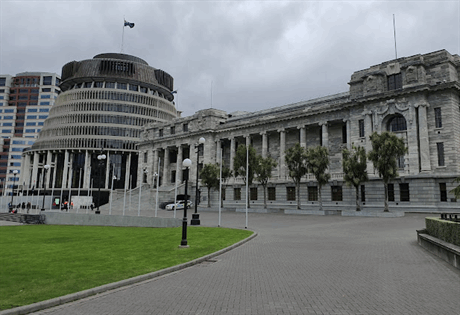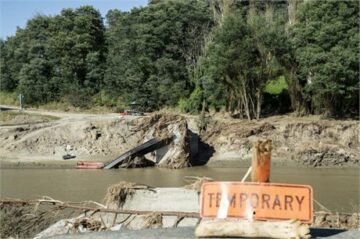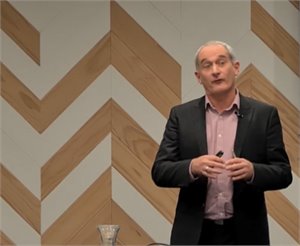The UN Secretary-General Antonio Guterres has warned, ‘Climate change is here. It is terrifying. And it is just the beginning.’ Given such warnings, are climate change’s urgency and significance adequately reflected in Aotearoa’s election debate? This assessment is made at around the midpoint of the election campaign. Notable gaps remain in some parties’ climate policy releases.
New Zealanders consider climate change to be important, but less important than several other issues facing Aotearoa, namely the cost of living, law and order, housing and health. In October 2021 New Zealand took on a tougher target (‘NDC’) of a 50% reduction in net greenhouse gas emissions by 2030, to help limit warming to 1.5°C.
A tougher target increases the pressure on the country to find effective policy actions, and to understand the cost of failing to do so. Aotearoa’s mediocre overall record in reducing emissions has received little attention domestically, but its variable leadership is noted internationally. For example, in an international Climate Change Performance Index, New Zealand ranked 30th in 2023, admittedly improved since 2017, when it was ranked 43rd (Germanwatch, 2023; also Climate Action Tracker, 2023).
There was little discussion of the critical nature of the climate emergency until the impact of Cyclone Gabrielle early in 2023. Given the trajectory of growing climate impacts, how seriously are political parties in Aotearoa now treating the (Paris agreement) goal and its implementation? The analysis here looks at climate policy positions of the main parties contesting the general election, focusing on the climate-linked issues of energy, transport, cities and housing. We first consider points of commonality and disagreement. We then consider these policy positions against the sort of policies recommended in international climate literature.
 |
| The Beehive |
Some agreement between major parties
There are some easy points of agreement in the energy domain – some positive common threads across Labour and National, such as accelerating consenting for renewable electricity, with a view that processes have become too cumbersome. However, this is pushing at an open door: a substantial number of windfarms have recently been consented and are now being developed, and developers are lining up to build solar farms. Speedier consenting may not be critical; other factors, such as grid investment, and a system operator ‘road map’ may matter more.
Labour appears eager to seem active on energy, with its 100% renewables goal and its announcement that asset manager BlackRock would put up a $2 billion fund for renewable energy investments aimed at lifting Aotearoa’s renewable share of electricity generation from under 90% currently to its target 100% by 2030. No details are public, but an expert analysis suggests that some partnerships could have strings attached. If anything comes of this initiative, any assurances given by the government around the electricity market or national grid investment need to be carefully examined.
Much the same can be said of public-private partnerships in the transport space. Both National and Labour appear to support PPPs, with Labour not ruling them out in regard to the $45 billion plan for two road tunnels and a light rail tunnel across Auckland’s Waitemata Harbour. Writer Max Rashbrooke argues that PPPs have a poor track record in Aotearoa, and are risky. It is also clear that government borrowing for infrastructure development is cheaper than using private capital.
Various implicit points of agreement also exist between National and Labour. One is an emphasis on big-ticket infrastructure, particularly road and tunnel building in Auckland. These, unfortunately, would likely be highly carbon-intensive, suggesting other paths may be better.
Another implicit point of consensus is around accepting that Aotearoa has no alternative but to take on the financial risk of buying substantial numbers of emission reduction units on the international market in future, rather than working faster to reduce domestic emissions to meet 2030 and 2050 commitments. If the international carbon market has hiccups, Aotearoa’s trade with the EU could be affected (Ballingal, 2023). In effect, the two main parties have agreed to take a risky punt on the international carbon market, rather than investing in faster domestic action.
More helpfully for Aotearoa’s climate policy, there are also points of agreement between Labour and the Green Party, for example around improving the energy and carbon performance of housing. The Greens have pledged a programme to decarbonise Kiwi homes (e.g. install solar panels; switch out of gas), including rental dwellings, with a ‘Clean Power Payment’, and it appears that Labour supports this, at least in principle. Also, both Labour and the Greens support major public transport investment, including bus electrification, and regional rail revival.
But parties disagree over many climate policies
Other policy positions command less agreement across parties, and typically some parties’ positions on particular issues overlook climate considerations. National, in particular, has pledged to build considerably more roads: it is ‘retreading’ its Key-era policy with a pledge of 13 new “roads of national significance”, many of which would be four-lane. Simeon Brown, transport spokesperson for National, said the 13 new roads would “unlock tens of thousands of new houses in Auckland, Hamilton, Tauranga and Wellington”, implying that urban sprawl’s damaging environmental consequences can be overlooked.
National’s $24 billion package would include some public transport investment, mainly in Auckland, but this would be heavily outweighed by private transport oriented highway building. The approach sets aside the compelling evidence that heavy road building would increase emissions and congestion, even if clean car take-up accelerated (Daalder, 2023; Wild, 2023) . The Green Party is concerned about both National’s road-intensive package, and Labour’s, noting that “two new three-lane urban motorway tunnels in a climate crisis is pouring fuel on the fire… ” and Labour ”should have prioritised the light rail”.
ACT holds that a minimalist approach to mitigation, relying on the Emissions Trading System, is preferred. It would, curiously, constrain the ETS market with its pledge to “[tie] New Zealand’s carbon price to the prices paid by our top five trading partners.” It also aims to “disestablish the Climate Change Commission” and repeal the Zero Carbon Act, although National has said it would not do this. ACT and National would withdraw Labour’s flagship Clean Car Discount policy, which has lifted e-cars (including hybrids) to about half of new car sales, but it is not clear yet whether they would seek another way, beyond the ETS, to accelerate EV sales and dampen sales of big emitters.
NZ First has essentially (at time of writing) no climate policy, although it supports electric trucks, its deputy leader Shane Jones has stated “We need to ensure the [Climate Change] commission does not become an echo chamber for prophets of doom,” and a party ‘principle’ (sic) is “pragmatic environmentalism.”
Te Pāti Māori (TPM) is critical of both Labour and Green party climate policy choices, even though its policies are closest to these parties. When PM Chris Hipkins failed to consult climate change minister James Shaw in March 2023 over the dropping of several emerging climate mitigation initiatives, including a social vehicle leasing scheme targeting low income groups, TPM argued that Shaw should resign over Labour’s backtracking. TPM has not yet released its climate election policy, but it is likely to repeat its 2022 call for urgent transformative policy action, particularly on agricultural emissions.
 |
| Te Pāti Māori is likely to call for urgent transformative policy. |
What would a preferable climate-related urban policy package look like?
It is widely accepted among climate policy analysts that reducing emissions is now so urgent that every credible policy lever has to be pulled to achieve a reduction in emissions and atmospheric concentrations before the risk of tipping points materialises. He Pou a Rangi [the Climate Change Commission, 2023] argues that ‘we must ensure we are reducing our gross emissions from all sources as much as possible and as soon as possible’. Relying on a narrow set of mitigation policy measures, some of which may fail, is too uncertain, and does not recognise the stakes involved (Axsen et al. 2020).
Relying on just one policy instrument, the ETS (in the case of ACT’s position), becomes riskier as the price needed to generate the necessary behavioural response rises over time, and the fiscal cost of failure (when Aotearoa needs to buy units in the international market) escalates. As the Treasury says, “These costs [of buying units offshore] represent a significant fiscal risk under all scenarios considered.” (Treasury & Ministry for the Environment, 2023, p.9).
Various commentators have noted that it is risky for a country to lag behind its ‘2030 trajectory’, including the risk of having to buy international units at high future prices. Others have emphasised the lack of attention to the disconnect between ambitious infrastructure-oriented policies and the cost Aotearoa will have to pay in terms of ‘making good’ the 2030 carbon gap that the country is heading towards. Labour seems barely more aware than National about this problem (Hickey, 2023). The Greens have been critical of other parties over their failure to connect the dots between transport policies such as road funding and a bow-wave of future carbon emissions. Other parties, including National, have in turn criticised the Greens for neglecting the impact of pro-climate policies on the cost of living.
Each sector also needs to play its part in reducing emissions, for the sake of equity, since sectors interact, and since policies which exempt one sector impose greater economic pressure on others. Given the scale of Aotearoa’s agricultural emissions, there is no case for exempting agriculture or delaying its entry into an ETS-type mechanism (Rogelj and Schleussner, 2019; Johnston, 2023; Germanwatch, 2023), or delaying further the reconfiguration of forestry’s problematic role.
A recent indication of the range of mitigation measures that could be taken in urban-related sectors by a developed country like Aotearoa, and the contribution of sectors to the overall mitigation effort, is provided in a Nature article by an international group of experts (Creutzig and colleagues, 2022). . The analysis focuses on measures on the ‘demand side’ alone, i.e. it sets aside technology such as electric vehicles and fuels. In the transport sector, key measures include:
‘Avoid [measures to avoid car travel]: active travel in highly accessible cities; teleworking, supported by compact, highly accessible city design and safe infrastructures for pedestrians and cyclists. …’
‘Shift [measures}: shared mobility and convenient and safe public transit. Pooled shared mobility with high occupancy and micro-mobility with high lifetime of vehicle stock; convenient rail-based public transit; supported by urban design and transit-oriented development, resulting in reduced travel distances….‘ [Table 1]
 |
| Compact urban development in London, UK. PHOTO: Ralph Chapman |
Aotearoa does not score well to date, in terms of these options, despite evidence that some of them would be relatively popular. As one indication of public opinion, a survey (n=436) conducted in December 2022 by the University of Auckland found that urban design and compact development measures were widely accepted as desirable: 92% agreed with a goal to “Increase urban density to make public transport and active forms (walking and cycling) of transport more affordable and attractive” (Bardsley et al., 2022). While this survey was not necessarily representative of the New Zealand population as a whole, it is in line with findings from in-depth studies of policy experts. One study across local and central government, NGOs, and independent experts (Hasan et al., 2020) found the strongest support, among 26 policy measures, for investment in active and public transport, and better accessibility through urban planning.
The wider New Zealand public’s opinions may, however, not align with urban policy experts’ views. As one journalist surmises, “Ford Ranger Man is winning because the politicians of both National and Labour understand …there are more swinging median voters who own homes in suburbs and provincial towns than there are non-car-driving renters in the big cities.”(Hickey, 2023). Labour’s response to date, in the transport domain, highlights public transport (decarbonising the fleet by 2035; mass rapid transit in Wellington). Curiously, it makes little of its effective clean car discount policy, preferring recently to talk up its road building plans, though these are less aggressive than National’s.
Significantly, some of the stated election positions of National and ACT work directly against the policy recommendations of international experts such as Creutzig. For example, National’s desire to see new roads expanding cities rather than facilitating compact urban development is at odds with developing more sustainable forms of transport, such as active transport including e-biking. National plans to build an additional six motorways beyond what Labour is planning (Wannan, 2023).
On cities and housing, National recently abandoned an October 2021 consensus about urban intensification reached with Labour, which allowed construction of three dwellings of up to three storeys (and on most sites up to 50% maximum coverage of the site) without the need for a resource consent. The consequence of National’s new stance and its road building plans would almost certainly be more greenfield housing development if it were elected, leading to a rise in long-distance urban commuting, greater investment in costly and carbon-intensive infrastructure, and higher transport sector emissions.
What is perhaps most concerning as Aotearoa heads towards the election is that many New Zealanders seem to have become resigned to giving away climate responsibility in favour of other goals, such as restraining the rising cost of living. For example, National’s pledge to abolish the clean car subsidy (discount) scheme would likely mean that prices of popular high-emissions utility vehicles would fall, and sales would rise once more, along with emissions. This would reinforce the effects of policies supporting urban sprawl, already a major housing sector challenge with rising net immigration numbers. Given the stalemate around agricultural emissions, which would be extended to 2030 with a National-ACT election win, it is not difficult to envisage one post-election scenario in which Aotearoa fails to take any real climate action, with the consequence that we as a country would fail to meet our ambitious 2030 target, and find ourselves on a very difficult path, potentially involving an ethically, legally and economically disastrous failure to meet the critical 2050 zero-carbon goal.
Ralph Chapman is Adjunct Professor at Te Herenga Waka – Victoria University of Wellington.
- SEO Powered Content & PR Distribution. Get Amplified Today.
- PlatoData.Network Vertical Generative Ai. Empower Yourself. Access Here.
- PlatoAiStream. Web3 Intelligence. Knowledge Amplified. Access Here.
- PlatoESG. Automotive / EVs, Carbon, CleanTech, Energy, Environment, Solar, Waste Management. Access Here.
- PlatoHealth. Biotech and Clinical Trials Intelligence. Access Here.
- ChartPrime. Elevate your Trading Game with ChartPrime. Access Here.
- BlockOffsets. Modernizing Environmental Offset Ownership. Access Here.
- Source: https://www.carbonnews.co.nz/story.asp?storyID=28597
- :has
- :is
- :not
- ][p
- $UP
- 1
- 13
- 2019
- 2020
- 2021
- 2022
- 2023
- 2030
- 2050
- 26
- 30th
- 9
- a
- About
- accelerate
- accelerated
- accelerating
- accepted
- accepting
- accessibility
- accessible
- Achieve
- across
- Act
- Action
- actions
- active
- Additional
- adequately
- adjunct
- affordable
- against
- agreed
- Agreement
- Agricultural
- agriculture
- aimed
- aims
- AL
- align
- All
- allowed
- almost
- alone
- along
- already
- also
- alternative
- Although
- ambitious
- among
- an
- analysis
- Analysts
- and
- Announcement
- Another
- any
- anything
- appear
- approach
- ARE
- argued
- Argues
- around
- AS
- assessment
- asset
- At
- atmospheric
- attached
- attention
- avoid
- aware
- away
- BE
- because
- become
- becomes
- been
- before
- Beginning
- behind
- being
- Better
- between
- Beyond
- Big
- Billion
- BlackRock
- Borrowing
- both
- brown
- build
- Building
- bus
- but
- buy
- Buying
- by
- call
- Campaign
- CAN
- capital
- car
- carbon
- carbon emissions
- carefully
- case
- central
- certainly
- challenge
- Chamber
- change
- choices
- Chris
- Cities
- City
- clear
- Climate
- climate action
- Climate change
- climate crisis
- CO
- colleagues
- comes
- commentators
- commission
- commitments
- Common
- commuting
- compact
- compelling
- concerned
- concerning
- conducted
- congestion
- Connect
- Consensus
- consent
- Consequences
- Consider
- considerably
- considerations
- considered
- construction
- contribution
- Convenient
- Cost
- costly
- Costs
- could
- country
- coverage
- credible
- crisis
- critical
- cumbersome
- Currently
- damaging
- Date
- debate
- December
- density
- deputy
- Design
- desire
- Despite
- details
- developed
- developers
- developing
- Development
- difficult
- direction
- directly
- disastrous
- Discount
- discussion
- do
- does
- domain
- Domestic
- domestically
- doom
- Door
- Dropping
- e
- E&T
- eager
- Early
- easy
- echo
- Economic
- effect
- Effective
- effects
- effort
- elected
- Election
- Electric
- electric vehicles
- electricity
- emergency
- emerging
- emission
- Emissions
- emphasis
- energy
- ensure
- entry
- Environment
- environmental
- equity
- essentially
- Ether (ETH)
- EU
- EV
- Even
- Every
- evidence
- example
- exempt
- exist
- expanding
- experts
- facilitating
- facing
- factors
- FAIL
- Failed
- failing
- fails
- Failure
- Fall
- faster
- financial
- Find
- findings
- First
- Fiscal
- five
- flagship
- FLEET
- focuses
- focusing
- For
- forms
- found
- from
- Fuel
- fuels
- fund
- funding
- further
- future
- gap
- gaps
- GAS
- General
- generate
- generation
- given
- Giving
- goal
- Goals
- Government
- Govt
- greater
- Green
- greenfield
- greenhouse gas
- Greenhouse gas emissions
- Grid
- gross
- Group
- Group’s
- Growing
- Hamilton
- Have
- having
- he
- Heading
- heads
- Health
- heavily
- heavy
- help
- here
- High
- higher
- highlights
- highly
- Highway
- holds
- Homes
- houses
- housing
- How
- However
- HTML
- HTTPS
- i
- if
- immigration
- Impact
- Impacts
- implementation
- important
- impose
- improved
- improving
- in
- in-depth
- include
- Including
- Income
- Increase
- Increases
- independent
- index
- indication
- Infrastructure
- infrastructures
- Initiative
- initiatives
- install
- instrument
- interact
- International
- internationally
- into
- investing
- investment
- Investments
- involved
- involving
- issues
- IT
- ITS
- james
- jones
- journalist
- jpg
- just
- just one
- Key
- Labour
- Lack
- Law
- leader
- Leadership
- leading
- leasing
- least
- legally
- less
- lifetime
- Lifted
- lifting
- light
- like
- likely
- LIMIT
- Line
- lining
- literature
- little
- living
- local
- London
- Look
- look like
- LOOKS
- Low
- made
- Main
- mainly
- major
- make
- MAKES
- man
- manager
- many
- March
- Market
- Mass
- Matter
- max
- maximum
- May..
- mean
- measures
- mechanism
- Meet
- minister
- ministry
- mitigation
- mobility
- more
- most
- much
- must
- namely
- narrow
- National
- Nature
- necessarily
- necessary
- Need
- needed
- needs
- neglecting
- net
- New
- New Zealand
- NGOs
- no
- notable
- noted
- noting
- now
- number
- numbers
- occupancy
- october
- Odds
- of
- on
- once
- ONE
- open
- operator
- Opinion
- Opinions
- Options
- or
- order
- Other
- Others
- our
- ourselves
- out
- over
- overall
- own
- package
- paid
- panels
- paris
- Paris Agreement
- part
- particular
- particularly
- parties
- partners
- partnerships
- party
- path
- Pay
- performance
- perhaps
- plan
- planning
- plans
- plato
- Plato Data Intelligence
- PlatoData
- Play
- Pledge
- Point
- points
- policies
- policy
- political
- political parties
- Politicians
- poor
- Popular
- population
- position
- positions
- positive
- possible
- potentially
- power
- preferable
- preferred
- pressure
- price
- Prices
- principle
- private
- Problem
- processes
- Professor
- programme
- provided
- Provincial
- public
- public opinion
- public transit
- Pushing
- put
- Rail
- range
- ranked
- rapid
- rather
- reached
- real
- received
- recent
- recently
- recognise
- recommendations
- recommended
- record
- reduce
- Reduced
- reducing
- reducing emissions
- reduction
- reflected
- regard
- regional
- reinforce
- relatively
- released
- Releases
- relying
- remain
- Renewable
- renewable energy
- Renewables
- Rental
- renters
- repeat
- represent
- representative
- resigned
- resource
- response
- responsibility
- resulting
- Rise
- Rises
- rising
- Risk
- Risky
- road
- roads
- Role
- ruling
- s
- safe
- Said
- sake
- sales
- same
- says
- Scale
- scenario
- scenarios
- scheme
- score
- sector
- Sectors
- see
- Seek
- seem
- seems
- seriously
- set
- Sets
- several
- Share
- shared
- shared mobility
- should
- significance
- significant
- since
- site
- Sites
- SIX
- So
- Social
- solar
- solar panels
- some
- Soon
- Sources
- Space
- spokesperson
- stated
- stock
- studies
- Study
- subsidy
- substantial
- such
- Suggests
- support
- Supported
- Supporting
- Supports
- Survey
- sustainable
- Switch
- system
- table
- Take
- taken
- Talk
- Target
- targeting
- Technology
- teleworking
- tens
- terms
- than
- that
- The
- The Greens
- their
- Them
- then
- There.
- These
- they
- this
- though?
- thousands
- three
- Through
- TIE
- time
- to
- too
- took
- top
- towards
- towns
- tpm
- track
- track record
- trade
- Trading
- trading system
- trajectory
- transformative
- transit
- transport
- travel
- treasury
- treating
- tunnel
- TURN
- two
- typically
- Uk
- Uncertain
- under
- understand
- unfortunately
- units
- university
- unlock
- until
- urban
- urgency
- urgent
- using
- utility
- variable
- vehicle
- Vehicles
- very
- Victoria
- View
- views
- voters
- walking
- was
- Way..
- we
- WELL
- were
- What
- when
- whether
- which
- while
- WHO
- whole
- widely
- wider
- will
- win
- winning
- with
- withdraw
- without
- Work
- working
- would
- writer
- writing
- yet
- Zealand
- zephyrnet
- zero












